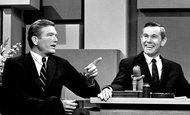While the network has yet to complete a deal, it has made a commitment to Jimmy Fallon, the current host of its “Late Night” program, to have him succeed Jay Leno as the next host of “Tonight,” according to several senior television executives involved in the decision. The show would move from Burbank, Calif., back to New York, where it first started in 1954 with Steve Allen as host.
Some details remain to be worked out, including an exact timetable for the switch, though it is expected to take place by the fall of 2014 at the latest, the executives said in interviews this week.
NBC has quietly begun work on a new studio in its headquarters building at 30 Rockefeller Plaza as the home for the new “Tonight” show. The studio is part of a general reconstruction of the building being undertaken by Comcast, which this week completed a full takeover of NBC Universal.
An NBC spokeswoman declined to comment on the move, other than to say the network was building a new state-of-the-art studio for Mr. Fallon.
A move to New York would return “Tonight” to its roots, after an absence of more than four decades. Beginning in 1954 the show was broadcast every evening from New York City, first from the Hudson Theater with Mr. Allen as host, followed by Jack Paar and Johnny Carson, both of whom worked at 30 Rock. But Mr. Carson, looking for easier access to Hollywood guests, as well as a different lifestyle, moved the show permanently to Burbank in 1972.
Mr. Fallon, who made his reputation at 30 Rock as a star on “Saturday Night Live,” now occupies the studio where Mr. Carson was working in the 1960s and early ‘70s. His “Late Night” show is broadcast at 12:35 a.m. Eastern time, following Mr. Leno on “Tonight.”

Don Hogan Charles/The New York Times.
Mayor John V. Lindsay of New York with Johnny Carson on “The Tonight Show” in 1966.
The changing of the guard on “Tonight” is one of the biggest personnel decisions in television, and has always been fraught with intrigue and backroom maneuvering. Three years ago, an effort to replace Mr. Leno with Conan O’Brien ended in recriminations and an ultimate reversal; Mr. Leno was reinstated as host after only seven months. NBC endured weeks of negative press coverage. In the early 1990s, Mr. Leno and David Letterman engaged in a heated and often acrimonious competition to replace Mr. Carson.
But NBC became concerned when ABC moved its own late-night star, Jimmy Kimmel, to go head-to-head with Mr. Leno and Mr. Letterman. Mr. Kimmel had been building his reputation as a host, generating well-received new ideas for the late-night format. He is also a generation younger than Mr. Leno and Mr. Letterman.
Many executives in the television business speculated that NBC could not afford to wait too long to promote Mr. Fallon, or it might risk having Mr. Kimmel lock up the younger-adult viewers that are the economic lifeblood of late-night television.
A New York “Tonight” show will join a metropolitan landscape already filled with late-night comedy shows, including “Late Show With David Letterman” on CBS and shows featuring Jon Stewart and Stephen Colbert on Comedy Central. One lingering question is what NBC will do with its “Late Night” franchise, which has always been a New York-based show.
Mr. O’Brien hosted that program before Mr. Fallon and it was speculated before his ascension to the “Tonight” show that he might try to keep working in New York, where he had thrived. But at the time NBC insisted “Tonight” had become a Hollywood-centric show and needed to stay in California.
Mr. Fallon quickly impressed NBC’s new management under Comcast, and his succession has been widely expected for at least a year. The only question has been when.
The potential timetable for the change — sometime within the next 18 months — has been tied to Mr. Leno’s current contract, which ends in the fall of 2014, as well as the need to sign Mr. Fallon to a new deal.
But one executive said NBC did not want Mr. Fallon to appear on the open market, where another network could try to woo him away — perhaps CBS, as a replacement for Mr. Letterman when he retired.
Given the past turbulence involved in changing hosts, NBC wants to make the transition to Mr. Fallon as smooth as possible. But the issue became both complicated and fractious in recent months.
The relationship between Mr. Leno and NBC became strained recently when the host told some jokes on his show about NBC’s poor performance in prime time, initiating a hostile e-mail exchange with Robert Greenblatt, the chairman of NBC Entertainment.
On Wednesday NBC said the conflict with Mr. Leno was being smoothed over.
Another complicating factor has been Mr. Leno’s continued success in the ratings.
When he was replaced by Mr. O’Brien, Mr. Leno was a dominant No. 1 in the late-night competition, and was unhappy to be asked to try to initiate a prime-time hour. When that show failed, and Mr. Leno was reinstated on “Tonight,” he eventually was able to regain his leadership in the ratings.
Indeed, Mr. Leno, as he often has in his career, has proved unexpectedly resilient in the ratings. In recent weeks, he has continued to finish first — always in the category of total viewers and usually among viewers between the ages of 18 and 49, the most sought-after age group for late-night advertisers.
As one of the executives involved in the planning of the shift to Mr. Fallon put it: “And then Jay manages to stay ahead of Kimmel. How often has that guy been underestimated?”
Article source: http://www.nytimes.com/2013/03/21/business/media/tonight-show-expected-to-return-to-new-york-with-fallon.html?partner=rss&emc=rss